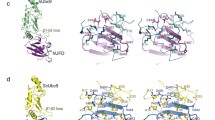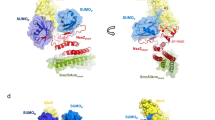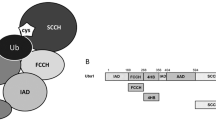Abstract
Small ubiquitin-like modifier (SUMO) conjugation and interaction play an essential role in many cellular processes. A large number of yeast proteins is known to interact non-covalently with SUMO via short SUMO-interacting motifs (SIMs), but the structural details of this interaction are yet poorly characterized. In the present work, sequence analysis of a large dataset of 148 yeast SIMs revealed the existence of a hydrophobic core binding motif and a preference for acidic residues either within or adjacent to the core motif. Thus the sequence properties of yeast SIMs are highly similar to those described for human. Molecular dynamics simulations were performed to investigate the binding preferences for four representative SIM peptides differing in the number and distribution of acidic residues. Furthermore, the relative stability of two previously observed alternative binding orientations (parallel, antiparallel) was assessed. For all SIMs investigated, the antiparallel binding mode remained stable in the simulations and the SIMs were tightly bound via their hydrophobic core residues supplemented by polar interactions of the acidic residues. In contrary, the stability of the parallel binding mode is more dependent on the sequence features of the SIM motif like the number and position of acidic residues or the presence of additional adjacent interaction motifs. This information should be helpful to enhance the prediction of SIMs and their binding properties in different organisms to facilitate the reconstruction of the SUMO interactome.










Similar content being viewed by others
References
Jones S, Thornton JM (1995) Protein-protein interactions: a review of protein dimer structures. Prog Biophys Mol Biol 63:31–65
Lo Conte L, Chothia C, Janin J (1999) The atomic structure of protein-protein recognition sites. J Mol Biol 285:2177–2198
Jones S, Thornton JM (1996) Principles of protein-protein interactions. Proc Natl Acad Sci U S A 93:13–20
Nooren IM, Thornton JM (2003) Diversity of protein-protein interactions. EMBO J 22:3486–3492
Pawson T, Nash P (2003) Assembly of cell regulatory systems through protein interaction domains. Science 300:445–452
Aloy P, Russell RB (2004) Ten thousand interactions for the molecular biologist. Nat Biotechnol 22:1317–1321
Gietz RD, Triggs-Raine B, Robbins A, Graham KC, Woods RA (1997) Identification of proteins that interact with a protein of interest: applications of the yeast two-hybrid system. Mol Cell Biochem 172:67–79
Young KH (1998) Yeast two-hybrid: so many interactions, (in) so little time. Biol Reprod 58:302–311
Aebersold R, Mann M (2003) Mass spectrometry-based proteomics. Nature 422:198–207
Gavin AC, Superti-Furga G (2003) Protein complexes and proteome organization from yeast to man. Curr Opin Chem Biol 7:21–27
Yu H, Braun P, Yildirim MA, Lemmens I, Venkatesan K, Sahalie J, Hirozane-Kishikawa T, Gebreab F, Li N, Simonis N, Hao T, Rual JF, Dricot A, Vazquez A, Murray RR, Simon C, Tardivo L, Tam S, Svrzikapa N, Fan C, de Smet AS, Motyl A, Hudson ME, Park J, Xin X, Cusick ME, Moore T, Boone C, Snyder M, Roth FP, Barabasi AL, Tavernier J, Hill DE, Vidal M (2008) High-quality binary protein interaction map of the yeast interactome network. Science 322:104–110
Gareau JR, Lima CD (2010) The SUMO pathway: emerging mechanisms that shape specificity, conjugation and recognition. Nat Rev Mol Cell Biol 11:861–871
Wimmer P, Schreiner S, Dobner T (2012) Human pathogens and the host cell SUMOylation system. J Virol 86:642–654
Cuchet D, Sykes A, Nicolas A, Orr A, Murray J, Sirma H, Heeren J, Bartelt A, Everett RD (2010) PML isoforms I and II participate in PML-dependent restriction of HSV-1 replication. J Cell Sci 124:280–291
Hay RT (2001) Protein modification by SUMO. Trends Biochem Sci 26:332–333
Müller S, Hoege C, Pyrowolakis G, Jentsch S (2001) SUMO, ubiquitin’s mysterious cousin. Nat Rev Mol Cell Biol 2:202–210
Namanja AT, Li YJ, Su Y, Wong S, Lu J, Colson LT, Wu C, Li SS, Chen Y (2012) Insights into high affinity small ubiquitin-like modifier (SUMO) recognition by SUMO-interacting motifs (SIMs) revealed by a combination of NMR and peptide array analysis. J Biol Chem 287:3231–3240
Reverter D, Lima CD (2005) Insights into E3 ligase activity revealed by a SUMO-RanGAP1-Ubc9-Nup358 complex. Nature 435:687–692
Song J, Zhang Z, Hu W, Chen Y (2005) Small ubiquitin-like modifier (SUMO) recognition of a SUMO binding motif: a reversal of the bound orientation. J Biol Chem 280:40122–40129
Sekiyama N, Ikegami T, Yamane T, Ikeguchi M, Uchimura Y, Baba D, Ariyoshi M, Tochio H, Saitoh H, Shirakawa M (2008) Structure of the small ubiquitin-like modifier (SUMO)-interacting motif of MBD1-containing chromatin-associated factor 1 bound to SUMO-3. J Biol Chem 283:35966–35975
Chang CC, Naik MT, Huang YS, Jeng JC, Liao PH, Kuo HY, Ho CC, Hsieh YL, Lin CH, Huang NJ, Naik NM, Kung CC, Lin SY, Chen RH, Chang KS, Huang TH, Shih HM (2011) Structural and functional roles of Daxx SIM phosphorylation in SUMO paralog-selective binding and apoptosis modulation. Mol Cell 42:62–74
Xu Y, Plechanovova A, Simpson P, Marchant J, Leidecker O, Kraatz S, Hay RT, Matthews SJ (2014) Structural insight into SUMO chain recognition and manipulation by the ubiquitin ligase RNF4. Nat Commun 5:4217
Hecker CM, Rabiller M, Haglund K, Bayer P, Dikic I (2006) Specification of SUMO1- and SUMO2-interacting motifs. J Biol Chem 281:16117–16127
Kerscher O (2007) SUMO junction-what’s your function? New insights through SUMO-interacting motifs. EMBO Rep 8:550–555
Lin DY, Huang YS, Jeng JC, Kuo HY, Chang CC, Chao TT, Ho CC, Chen YC, Lin TP, Fang HI, Hung CC, Suen CS, Hwang MJ, Chang KS, Maul GG, Shih HM (2006) Role of SUMO-interacting motif in Daxx SUMO modification, subnuclear localization, and repression of sumoylated transcription factors. Mol Cell 24:341–354
Stehmeier P, Muller S (2009) Phospho-regulated SUMO interaction modules connect the SUMO system to CK2 signaling. Mol Cell 33:400–409
Chang PC, Izumiya Y, Wu CY, Fitzgerald LD, Campbell M, Ellison TJ, Lam KS, Luciw PA, Kung HJ (2010) Kaposi’s sarcoma-associated herpesvirus (KSHV) encodes a SUMO E3 ligase that is SIM-dependent and SUMO-2/3-specific. J Biol Chem 285:5266–5273
Meulmeester E, Kunze M, Hsiao HH, Urlaub H, Melchior F (2008) Mechanism and consequences for paralog-specific sumoylation of ubiquitin-specific protease 25. Mol Cell 30:610–619
Cai Q, Cai S, Zhu, C, Verma, SC, Choi JY, Robertson ES (2013) A Unique SUMO-2-Interacting Motif within LANA Is Essential for KSHV Latency. PLoS Pathog 9:e1003750
Makhnevych T, Sydorskyy Y, Xin X, Srikumar T, Vizeacoumar FJ, Jeram SM, Li Z, Bahr S, Andrews BJ, Boone C, Raught B (2009) Global map of SUMO function revealed by protein-protein interaction and genetic networks. Mol Cell 33:124–135
Sung MK, Lim G, Yi DG, Chang YJ, Yang EB, Lee K, Huh WK (2013) Genome-wide bimolecular fluorescence complementation analysis of SUMO interactome in yeast. Genome Res 23:736–746
Srikumar T, Lewicki MC, Raught B (2013) A global S. cerevisiae small ubiquitin-related modifier (SUMO) system interactome. Mol Syst Biol 9:668
Hannich JT, Lewis A, Kroetz MB, Li SJ, Heide H, Emili A, Hochstrasser M (2005) Defining the SUMO-modified proteome by multiple approaches in Saccharomyces cerevisiae. J Biol Chem 280:4102–4110
Armstrong AA, Mohideen F, Lima CD (2012) Recognition of SUMO-modified PCNA requires tandem receptor motifs in Srs2. Nature 483:59–63
Kolesar P, Sarangi P, Altmannova V, Zhao X, Krejci L (2012) Dual roles of the SUMO-interacting motif in the regulation of Srs2 sumoylation. Nucleic Acids Res 40:7831–7843
Gilbreth RN, Truong K, Madu I, Koide A, Wojcik JB, Li NS, Piccirilli JA, Chen Y, Koide S (2011) Isoform-specific monobody inhibitors of small ubiquitin-related modifiers engineered using structure-guided library design. Proc Natl Acad Sci U S A 108:7751–7756
Crooks GE, Hon G, Chandonia JM, Brenner SE (2004) WebLogo: a sequence logo generator. Genome Res 14:1188–1190
Guex N, Peitsch MC (1997) SWISS-MODEL and the Swiss-Pdb Viewer: an environment for comparative protein modeling. Electrophoresis 18:2714–2723
Mossessova E, Lima CD (2000) Ulp1-SUMO crystal structure and genetic analysis reveal conserved interactions and a regulatory element essential for cell growth in yeast. Mol Cell 5:865–876
Case DA, Darden TA, Cheatham TEI, Simmerling CL, Wang J, Duke RE, Luo R, Walker RC, Zhang W, Merz KM, Roberts B, Hayik S, Roitberg A, Seabra G, Swails J, Goetz AW, Kolossváry I, Wong KF, Paesani F, Vanicek J, Wolf RM, Liu J, Wu X, Brozell SR, Steinbrecher T, Gohlke H, Cai Q, Ye X, Wang J, Hsieh M-J, Cui G, Roe DR, Mathews DH, Seetin MG, Salomon-Ferrer R, Sagui C, Babin V, Luchko T, Gusarov S, Kovalenko A, Kollman PA (2012) AMBER 12. University of California, San Francisco
Hornak V, Abel R, Okur A, Strockbine B, Roitberg A, Simmerling CL (2006) Comparison of multiple Amber force fields and development of improved protein backbone parameters. Proteins 65:712–725
Jardin C, Horn AHC, Schürer G, Sticht H (2008) Insight into the phosphoryl transfer of the Escherichia coli glucose phosphotransferase system from QM/MM simulations. J Phys Chem B 112:13391–13400
Mazumder ED, Jardin C, Vogel B, Heck E, Scholz B, Lengenfelder D, Sticht H, Ensser A (2012) A molecular model for the differential activation of STAT3 and STAT6 by the herpesviral oncoprotein tip. PLoS One 7:e34306
Jardin C, Sticht H (2012) Identification of the structural features that mediate binding specificity in the recognition of STAT proteins by dual-specificity phosphatases. J Biomol Struct Dyn 29:777–792
Ryckaert JP, Ciccotti G, Berendsen HJC (1977) Numerical integration of the cartesian equations of motion of a system with constraints: molecular dynamics of n-alkanes. J Comput Physiol 23:327–341
Humphrey W, Dalke A, Schulten K (1996) VMD: Visual molecular dynamics. J Mol Graph 14:33–38
Accelrys Software Inc (2004) Discovery Studio Modeling Environment, Release 2.1. Accelrys Inc, San Diego
Dinkel H, Van Roey K, Michael S, Davey NE, Weatheritt RJ, Born D, Speck T, Kruger D, Grebnev G, Kuban M, Strumillo M, Uyar B, Budd A, Altenberg B, Seiler M, Chemes LB, Glavina J, Sanchez IE, Diella F, Gibson TJ (2014) The eukaryotic linear motif resource ELM: 10 years and counting. Nucleic Acids Res 42:D259–266
Escobar-Cabrera E, Okon M, Lau DK, Dart CF, Bonvin AM, McIntosh LP (2011) Characterizing the N- and C-terminal small ubiquitin-like modifier (SUMO)-interacting motifs of the scaffold protein DAXX. J Biol Chem 286:19816–19829
Selzer T, Albeck S, Schreiber G (2000) Rational design of faster associating and tighter binding protein complexes. Nat Struct Biol 7:537–541
Kiel C, Selzer T, Shaul Y, Schreiber G, Herrmann C (2004) Electrostatically optimized Ras-binding Ral guanine dissociation stimulator mutants increase the rate of association by stabilizing the encounter complex. Proc Natl Acad Sci U S A 101:9223–9228
Acknowledgments
The project was funded by the Deutsche Forschungsgemeinschaft (SFB796, project A2) to HS. The authors thank Melanie Schneider and Jakob Bader for fruitful discussions, as well as Thomas Zeiser from the High Performance Computing group of the Regionales Rechenzentrum Erlangen (RRZE) for providing optimized AMBER executables.
Author information
Authors and Affiliations
Corresponding author
Electronic supplementary material
Below is the link to the electronic supplementary material.
Figs. S1–S4
Showing details of the control simulations, which used the alternative ySUMO template, are available as supplementary material. (DOCX 3022 kb)
Rights and permissions
About this article
Cite this article
Jardin, C., Horn, A.H.C. & Sticht, H. Binding properties of SUMO-interacting motifs (SIMs) in yeast. J Mol Model 21, 50 (2015). https://doi.org/10.1007/s00894-015-2597-1
Received:
Accepted:
Published:
DOI: https://doi.org/10.1007/s00894-015-2597-1




